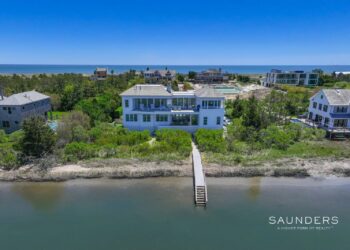Montauk is the white-hot destination for the millennials on the most eastern tip of Long Island. Celebrities galore are being seen in Montauk as they were in the late 1960’s and early 1970’s when some of The Beatles, The Rolling Stones and the “avant-garde” friends of famous photographers Peter Beard and Andy Warhol were running around Montauk with their entourages. So let’s look back to see how Montauk has evolved.
The Montauket Indians inhabited the Montauk area first. In the early 1600’s, before the English arrived on the extreme east end from Lynn, Massachusetts (in 1640 through 1648 period), the Dutch actually referred to Montauk Point as Fisher Point.
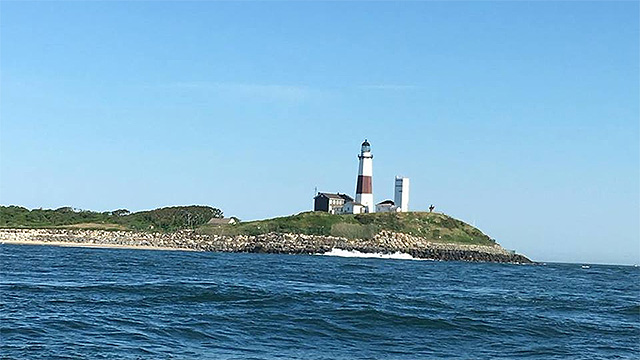 |
|
The Montauk Lighthouse was commissioned to be built by newly sworn in President Washington on April 12, 1792. (Photo: Nicole Barylski) |
Then during the American Revolution, the British Military used Montauk as a grazing area for the livestock that feed the British Army that occupied the East End. Afterwards, the Montauk Lighthouse was commissioned to be built by newly sworn in President Washington on April 12, 1792.
Although the population of Montauk was under 100 during the Civil War, there was an ironclad vessel exactly the same as the famous USS Monitor named the USS Montauk. The body of John Wilkes Booth (Abraham Lincoln’s assassin) was brought to the USS Montauk while it was anchored near Washington D.C. in the Potomac River to be examined by government officials.
After the Spanish American War, Teddy Roosevelt and his rough riders were quarantined at what was then called Camp Wikoff with up to 3,200 ill soldiers on 4,000 Montauk acres owned by the LIRR.
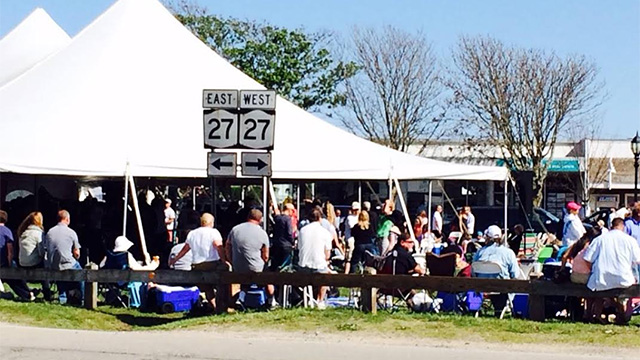 |
|
A well attended community event. (Photo: T.J. Clemente) |
The Pearl Harbor aftermath had both the US Army and Navy come to Montauk. In 1942 Camp Hero (named after the Army’s chief of coastal artillery of the 1920-1930’s, Gen. Andrew Hero) was opened as part of the US coastal defense network. Also in 1942 the US Navy gave the residents of Montauk Village thirty days notice that it was going to demolish everything and locate a facility to test torpedoes. That was not real popular with the locals.
Post WWII, the US Air Force came into Montauk and built the huge radar station to track Russian planes and missiles. They left for good in in 1981.
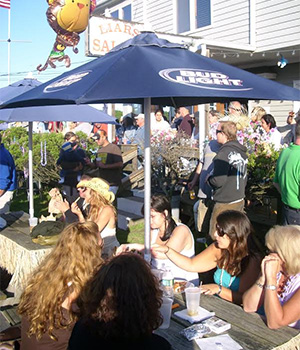 |
|
Liar’s Saloon in Montauk. (Photo: T.J. Clemente) |
But Montauk looks a lot different nowadays, and these perhaps are the four major events that transferred Montauk from a remote fishing village to what it is today.
1. The completion of the LIRR service to Montauk in 1895.
2. Carl Fisher and his vision of Montauk being the Miami of the North, including dredging Montauk Lake and opening it up to Block Island Sound in 1923-29.
3. World War II relocation of the Village from the Navy Road area to where it is today on Route 27.
4. The post World War II affordable housing building development.
During and after World War II there was a lot of new growth activity in changing Montauk. A prime example is the story of Gosman’s dock. In 1943 Robert Gosman purchased what is now called Gosman’s Dock from the Bonner Fuel Company. Roberta Gosman Donovan, Robert’s daughter recalls, “It was where people bought fuel, back then there were only two docks, Bonner’s and the Montauk Yacht Club.” In fact, before the dredging according to Roberta one could actually walk from Gosman’s dock out to Star Island over the mud in the harbor. It wasn’t until 1946 that the first Gosman’s Restaurant was built and it was just a bit more than a shack. Back then people sat on old fish boxes to eat. Roberta explains, “We opened it because it was miles from the nearest place to get coffee and chowder. The original restaurant was only opened for breakfast and lunch. It was basically for the commercial fisherman who kept their boats at the dock.”
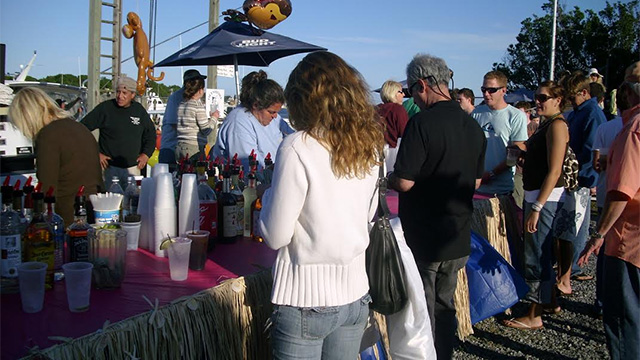 |
|
Montauk in 2009. (Photo: T.J. Clemente) |
Today Gosman’s is an empire with three restaurants, Gosman’s Dock Restaurant, Top Side and Inlet Café, and Gosman’s Clam Bar (stand-up and take out). All this is located on 5 acres with well over 800 feet of waterfront. Founder Robert Gosman was from Amagansett where his dad worked for the Long Island Rail Road. He met his wife Mary, who was from Ireland (County Kloone Kerin), during a summer romance while they both had summer season jobs in East Hampton. This year Gosman’s Dock was put up for sale with an asking price of $52.5 million!
After the war many housing developers came to Montauk to build affordable second homes for the post WWII boom. Whole new sections were built instantly. It was then Montauk received its “blue collar unhampton” reputation. It stayed that way even through a second building craze in the 1980’s.
 |
|
The beautiful sunsets haven’t changed. (Photo: Nicole Barylski) |
PJ Delia grew up at Camp Hero in the 1960’s, when it was an Air Force Radar Base 773rd Radar Squadron. PJ is a well-liked and known local who is also the wife of Joe Delia, the founder of the band Joe Delia and the Thieves. She also sings with the band. They have owned a home in Montauk forever. She shared some of her thoughts about the Montauk social bar and club scene over the last 40 years.
“In my memory, as an underage person then, the hottest (most notorious place) in the early ’70s was the Pirate’s Den. It had an open rooftop strung with lights and everyone could see and hear people dancing at night,” she said. “It was fascinating and there weren’t that many houses nearby.” That locale is now The Sloppy Tuna. “That building got a beautiful overhaul in the mid-70s and became the Sunrise. That was full day and night. Daytime drinks on the front deck, sometimes to go,” added Delia. “Mom and Dad would imbibe while the kids played in the ocean. At night, everyone 18 and up would flock there, nicely dressed to see and be seen, having dinner or dancing to disco music or just meeting summer loves. It was clean and light inside and out.”
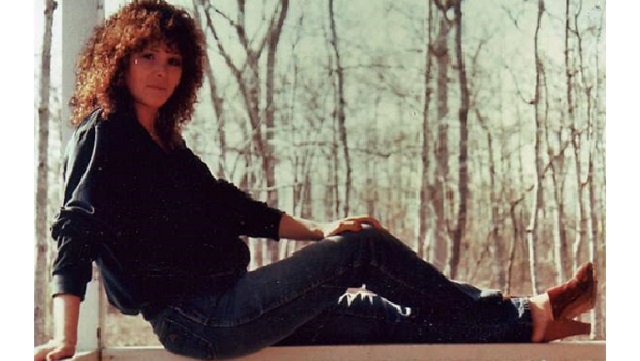 |
|
PJ Delia took us down memory lane. (Courtesy Photo) |
At this same time, The Rolling Stones spent a summer staying at Andy Warhol’s Montauk estate, reportedly drinking, playing pool and the piano at the Memory Hotel.
 |
|
PJ Delia. (Photo: Daniel Gonzalez) |
When asked about the 1980’s, PJ Delia said, “During the ’80s, that same place became a succession of other clubs. I think the Mimosa was the best one at that location in that time. The hottest place during the ’80s hands down was The Montauk Yacht Club. Celebrities and the extremely wealthy flocked there. Seaplanes were dropping off guests all day long, all week long. Fashions were started there, including the Members Only jackets, remember them?”
Then came the 1990’s, PJ recalls, “During the ’90s, I feel the hottest Montauk spots were created by decades of old ownership ending in two places. The Memory [Motel] had changed hands and transformed from an old man’s all day drinking bar run by two little old ladies to a club packed with summer partiers. The Shabeen, if I remember correctly, was when the Blue Marlin changed hands and the Irish summer workers sparked it up. The Old Lakeside Inn starting becoming a hotspot too, eventually getting a beauty treatment by Jayma Cardoso that made it the world famous Surf Lodge.”
By 2005, the Montauk Friend’s of Erin St. Patrick’s Day Parade in late March was drawing 50,000 people to Montauk, and that became a problem. The young millennials were coming of age and a pattern of bad behavior drunkenness and violence marred what was once only a joyous family oriented day. The Town of East Hampton, along with the “Parade” organizers, took steps to curtail any bad behavior. They tinkered with closing the bars, changing the time of the parade and monitoring the LIRR trains for underage drinking.
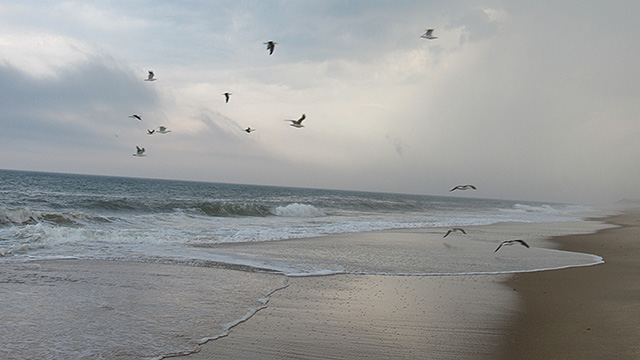 |
|
The beaches have become even more popular. (Photo: Nicole Barylski) |
I went to the opening weekend (April 30, 2008) of The Surf Lodge with Montauk legend Carl Darenberg. In ten seconds we both could see the change coming to Montauk. We were introduced to the next generation of folks discovering Montauk. The crowds that year were unbelievable. Soon what I call the “Surf Lodge effect” drew in the Hollywood superstars. Think about it, Leonardo DiCaprio could and would hang out in the south of France, or Malibu, or Miami, yet there he was now at the Surf Lodge in Montauk. That brings us to the present time where Montauk may be one of the centers of “Millennial Culture.” While the locals feel like the town is being invaded, it is really a new generation discovering “The End” of Long island via the “scene” in Montauk.
It is this last reminisce where PJ Delia paints a portrait of a Montauk now long gone: “We lived for the summer when we were teens in Montauk, much like teens do everywhere. However, we were let loose in a very wild and free environment. We walked barefoot, hitchhiked and sometimes rode our friend’s horse into the Village to see what was happening. And there was always something happening. The surfers would be lined up for coffee at 7 a.m., their hair bleached out from sun and salt, their skin sleek and tan from the sun, and their eyes smarting from last night’s parties. We’d go to work shucking clams or cleaning motel rooms. Then, at sunset, we’d have cash and would be allowed to wander the streets or other events. Mick and other Stones would sometimes be wandering in and out of The Shagwong or Foxies across the street, always fun to watch. There were horse events, in which Christie Brinkley would participate in things like barrel racing and Keith (Richards) may be watching from the fence. Paul Simon would have huge outdoor concerts. It was teen heaven and we would wander it relatively safely.”
So hopefully this sketch of the evolution of Montauk is helpful in understanding where it was and where it is going.



